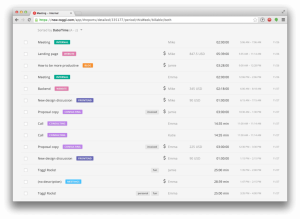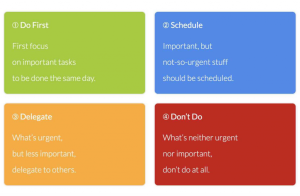14 Ways to be More Productive at Home, at Work, and in Life
What does it mean to be productive?
We all strive to be more productive. Being productive is one of those things which are generally accepted as good, such as being kind, compassionate, or helpful. The problem is, most people don’t know how to define productivity.
To be productive means to be effective at externally rewarding tasks. In other words, you’re productive when you’re successfully handling a task which is not internally rewarding.
The point of being productive and completing your tasks more efficiently is to free up time for doing the things you love. And finally, most productivity tips limit themselves to discussing productivity at work, which is also limiting: you can also be more productive at home and in your life in general.
14 tips for improving your productivity
Here are some of the easiest ways to enhance your productivity and get more things done in less time. We’ve split up the tips into three categories: Work, Home, and Life.
Work
1. Time your tasks with a time tracker
You can’t improve what you don’t measure. One of the simplest ways to become more productive is to start tracking your time at work. Once you see where your time goes every day and which tasks demand the most out of your workday, you will be able to readjust your priorities and find out whether some tasks even belong in your to-do list. Toggl Track is a great tool for measuring how long it takes for you to complete certain tasks.

2. Have a to-do list
A lot of the time we find it hard to be productive simply because we have no idea what is even on our plate in terms of tasks. A simple list of tasks can provide a major breakthrough in regaining control. If you want to go old school, you can use a simple sheet of paper and cross off the completed tasks. Or you can save a tree and go digital. The Toggl Track Starter plan includes a Task feature that functions as a to-do list.

3. Prioritize using the Eisenhower Matrix
If you’re looking for a quick way to manage a major workload, the Eisenhower Matrix may be just the tool for you. Former U.S. President Dwight D. Eisenhower came up with his matrix, also known as the Urgent-Important matrix, as he often had to make difficult decisions.
The Eisenhower Matrix essentially forces you to sort all of your tasks into one of four buckets according to their urgency and importance. Depending on which bucket your task belongs in, you can do first, schedule, delegate, or eliminate the task in question. It’s a super simple method that works even today.
4. Break down big tasks into smaller ones
When eating an elephant, as the old adage goes, take one bite at a time. Even the most daunting tasks in the world can appear simple and easy to pull off if they’re cut down into smaller tasks. There are plenty of benefits to breaking up your tasks. You get feedback more quickly, you don’t procrastinate as much and, according to one doctor, this way of work is simply better for our relatively poor memory capacity.
5. Eliminate unnecessary communication
For those of us working remotely, constantly being online and responsive can be a way to demonstrate how hard we’re working. However, spending too much time in Slack can actually tank your productivity. One study from 2015 found that push notifications are just as distracting for productivity as phone calls or messages, even when we ignore them. Most of today’s communication apps allow you to turn off your notifications, which you should definitely do if you want to get more work done instead of sending messages all day.
Home
6. End your day even when you feel like you could continue
Writer Ernest Hemmingway had a great productivity tip: stop with your work for the day when the work is going great. That way, your mind will subconsciously work on the task until you start up again the following day. If you end your day at a point where you’re struggling, you might end up consciously thinking about work, making it difficult to get started again.
7. Don’t multitask
Even as adults, many of us have a deep respect for our multitasking mothers, many of whom juggled three or four tasks at a time. Anyone who can prepare your lunch, help out with homework, get ready for work, and all do all of that while on the phone with someone for work deserves our respect. However, splitting your attention between multiple goals only seems to save time. There is solid research to back up the statement that multitasking is a myth.
While we think that we are (successfully) doing two things simultaneously, we are merely switching between tasks at a rapid pace. When you’re focusing on two goals at once, you’re giving neither your full, undivided attention and focus. As a result, you’re not doing anything to your full capacity. Unlike many of our mothers, we often have the choice not to multitask. So focus on just one goal and one task at a time and do it incredibly well.
8. Find your peak hours
We all have the same 24 hours in the day but for better or for worse, we’re not all at our most productive at the same time. Our days are split up in blocks of time and about every 90 minutes, we hit a block of productivity called an ultradian cycle. These are your peak productivity times, and this is when you should do your most important work, which requires your full attention. You can complete your less demanding tasks during the periods when you’re not at your most productive.
Of course, you’ll need to do some research and log your moods and habits to find your ultradian cycles (it’s different for everyone). But once you do, you’ll know exactly when you’re at your most productive.
9. Exercise, even if it’s just a short walk
No matter the source, you’ll hear that exercising has numerous benefits for the human body. One of the benefits is productivity. Even something quick like a short walk will get your blood pumping and increase your alertness, ultimately making you more productive. You don’t need to go to a gym–just a brisk walk around your house or building will do. Alternatively, there are also lots of home workout programs that you can do indoors, with minimal or no equipment needed.
Life
10. Ask for help when you feel stuck
There are two paths you can take when things are not going well. You can either battle it out on your own or get help. While pride may get in your way, you have to bear in mind that one of the easiest ways to be more productive and save a ton of time is to ask someone more experienced for help. It doesn’t even have to be someone more experienced or smarter–even getting a second opinion can make a world of difference sometimes.
11. Take breaks
When you’re feeling stuck, it’s always a good idea to take a breather. Even if you’re not stuck, and doing well at a certain task, you still need time off to recharge. One good way to systemize this is with the Pomodoro technique, where you split up your work in 25-minute blocks, followed by 5-minute breaks. You can use the Pomodoro technique with Toggl Track: it’s a built-in feature!
12. Wake up early
There is research to back up the fact that waking up early may be advantageous in many ways. People who wake up early reach their full state of wakefulness earlier and can hit the ground running sooner. Moreover, according to the results of the above survey, early risers tend to get better grades, get into better universities and generally fare better in their careers which in turn can influence your personal life for the better.
13. Avoid social media
Globally, people spend 2 hours and 24 minutes daily on social media, according to a recent report from marketing research firm GlobalWebIndex.
So, if you’re wondering where all your time has gone and why you can’t get anything done, it could be the time that you spend on Twitter, Instagram, or Facebook every day. Make sure you monitor your use of social media – it’s actually pretty easy to do on your phone. You can use Toggl Track to track not just the time you spend on work, but also on social media.
14. Identify the tasks you spend the most time on
To improve your productivity, you need to spend your time wisely. It’s very possible that you’re spending a lot of it on tasks that are irrelevant. The best way to find out which tasks drain your time is to start tracking it, either manually or using an app like Toggl Track. Once you start taking an honest look at your time distribution, you’ll be able to spot whether the majority of your time is spent on unimportant tasks or tasks that don’t really contribute to your ultimate goals.
If you find this article useful, please share it on social media. Please follow us on social media also.
